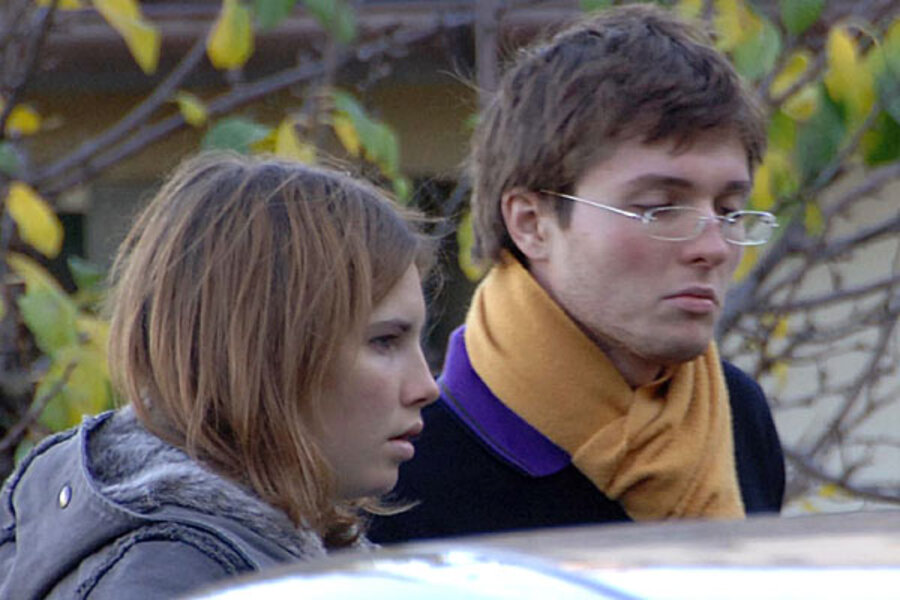Amanda Knox: Ex-boyfriend says 'bizarre' behavior led to police suspicion
Loading...
| Seattle
Raffaele Sollecito, whose budding love affair with American exchange student Amanda Knox helped land him in an Italian prison for four years, maintains the couple's innocence in a new book but acknowledges that their sometimes bizarre behavior after her roommate's killing gave police reason for suspicion.
The pair was imprisoned for the November 2007 death of Meredith Kercher at Knox's apartment in Perugia, north of Rome. An appeals court overturned their conviction and freed them last fall, issuing a 143-page opinion that blasted the utter lack of evidence against them. Rudy Guede, a petty criminal who was convicted separately, remains imprisoned and is serving a 16-year-sentence.
Sollecito's book, "Honor Bound," is due out Sept. 18. The Associated Press purchased a copy Tuesday.
IN PICTURES: Amanda Knox goes home
In it, her Italian boyfriend describes how the early days of their relationship became a nightmare: the horror of Kercher's slaying; the misunderstandings that swept them up in the case; their tabloid portrayals as two suspects unrecognizable to themselves.
Knox became "Foxy Knoxy" and received the brunt of the attention as she shopped for underwear after the killing and turned cartwheels in front of investigators. While police investigated the crime scene, Sollecito caressed her and they kissed, unaware of the television news cameras across the street.
Later at the police station she climbed in his lap and draped her arms over him, making Sollecito uneasy, he said.
Police found their behavior "odd" and he acknowledged they had no "real alibi the night of Nov. 1 except each other."
Knox is also writing a book, due out next spring. Her deal, with HarperCollins, is reportedly worth $4 million.
The couple were arrested several days after Kercher's death and later convicted in proceedings that made headlines around the world. Prosecutors portrayed the case as a drug-fueled sexual assault, and Knox and Sollecito were sentenced to 26 years and 25 years, respectively.
The appeals court found the prosecution's theory to be unsupported by any evidence. Prosecutors have appealed the acquittal, and Italy's highest court will hear their arguments next March.
Sollecito frequently criticizes the police for their handling of the case, reaching for a far-fetched conspiracy instead of the simpler explanation that Guede had on his own committed a burglary gone wrong.
Sollecito, then finishing his undergraduate studies in computer science, writes that he met Knox at a classical music concert at the Universita per Stranieri, the University for Foreigners, on Oct. 25, 2007 — a week before Kercher's death. He asked for her number, and she told him to come by the bar where she'd be working later that night. At the end of the shift, he writes, they took a walk, held hands and kissed. She accepted an invitation to come back to his apartment and spent the night.
Soon the couple became inseparable. She began spending the nights at his apartment. They shopped for groceries together, and took a sightseeing day trip to Assisi.
Sollecito wrote about his first night in prison, saying he wavered between "great waves of indignation and a nagging sense of guilt." He said that while he knew he was innocent, he was angry at himself for having a foggy memory of the night of the killing because he and Knox had smoked marijuana.
When they were finally acquitted, Sollecito writes that he felt "indescribable joy." He remembers looking at the police, hoping to see them appear defeated, but they wouldn't look at him. He saw Knox sobbing, and they later had a private moment in the basement of the courthouse, waiting to be taken back to prison one last time. According to Sollecito, she squeezed his hand and said she couldn't wait to see her home and friends.
Knox moved back to Seattle. It's not clear where Sollecito is living.
IN PICTURES: Amanda Knox goes home
___
Johnson can be reached at https://twitter.com/GeneAPseattle
___
AP writers Manuel Valdes and Rachel La Corte contributed to this report.
Copyright 2012 The Associated Press.







